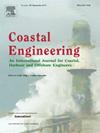耗散海滩上的浪涌提取:基于视频的新方法
IF 4.5
2区 工程技术
Q1 ENGINEERING, CIVIL
引用次数: 0
摘要
涨潮观测对海岸管理非常重要,为验证淹没频率和侵蚀率的预测模型提供了数据,这对于评估沿海生态系统和基础设施的脆弱性至关重要。在耗散条件下,从视频图像中提取瞬时水线的自动算法会遇到困难,因为存在渗水面,而且砂和冲刷之间缺乏对比,这阻碍了正确的提取,需要耗费大量时间的数据质量控制或手动数字化。本研究引入了两种新的方法,基于颜色对比(CC)和机器学习(ML)。CC方法将纹理粗糙度(局部熵)与饱和度相结合。首先使用熵值对图像进行二值化,然后通过对饱和通道进行二值化降噪来细化图像。ML方法使用卷积神经网络(CNN),该网络由五个通道组成:灰度强度及其时间梯度、饱和通道、熵及其时间梯度。两种方法都针对9个手动标记的80分钟视频时间序列进行了验证。CC方法与人工数字化水线高度吻合(RMSE = 0.12 m, r=0.94);RMSE = 0.08 m, r=0.97 (R2%);平均周期的RMSE = 3.88 s, r=0.70 (Tm−1,0))。ML模型与人工标记的时间序列比较好(RMSE = 0.10 m, r=0.96);R2%时RMSE = 0.09 m, r=0.97;RMSE = 3.51 s, r=0.79 (Tm−1,0)。此外,两种方法计算的R2%值与Stockdon等人(2006)在极耗散条件下提出的公式非常吻合,手动、CC和ML估计的rmse值低于0.13 m,相关性超过0.70。虽然CC方法被认为适用于类似耗散条件下的逐波分析,具有光滑的渗流面和足够的湍流冲刷,但ML方法仍然难以处理新的、看不见的数据。然而,它显示出更广泛的应用前景,并作为一个可行的概念证明。总之,这些方法减少了人工处理的需要,增强了实时海岸监测,有助于更准确地预测上升事件的建模,并更好地了解近岸过程。本文章由计算机程序翻译,如有差异,请以英文原文为准。
Wave runup extraction on dissipative beaches: New video-based methods
Wave runup observations are important for coastal management providing data to validate predictive models of inundation frequencies and erosion rates, which are vital for assessing the vulnerability of coastal ecosystems and infrastructure. Automated algorithms to extract the instantaneous water line from video imagery struggle under dissipative conditions, where the presence of a seepage face and the lack of contrast between the sand and the swash impede proper extraction, requiring time-intensive data quality control or manual digitization. This study introduces two novel methods, based on color contrast (CC) and machine learning (ML). The CC method combines texture roughness — local entropy — with saturation. Images are first binarized using entropy values and then refined through noise reduction by binarization of the saturation channel. The ML method uses a convolutional neural network (CNN) informed by five channels: the grayscale intensity and its time gradient, the saturation channel, and the entropy and its time gradient. Both methods were validated against nine manually labeled, 80 min video time series. The CC method demonstrated strong agreement with manually digitized water lines (RMSE = 0.12 m, for the vertical runup time series; RMSE = 0.08 m, for the 2% runup exceedance (); and RMSE = 3.88 s, for the mean period ()). The ML model compared well with the manually labeled time series (RMSE = 0.10 m, for the vertical runup time series; RMSE = 0.09 m, for ; and RMSE = 3.51 s, for ). Furthermore, the computed values of both methods show a good agreement with the formula proposed by Stockdon et al. (2006) for extremely dissipative conditions, with RMSE-values lower than 0.13 m and correlations exceeding 0.70 for manual, CC, and ML estimates. While the CC method is deemed applicable for wave-by-wave analysis under similar dissipative conditions with a smooth seepage face and sufficient turbulent swash, the ML method still struggles with new, unseen data. However, it shows promise for a broader application and serves as a viable proof of concept. Together, these methods reduce the need for manual processing and enhance real-time coastal monitoring, contributing to more accurate predictive modeling of runup events and a better understanding of nearshore processes.
求助全文
通过发布文献求助,成功后即可免费获取论文全文。
去求助
来源期刊

Coastal Engineering
工程技术-工程:大洋
CiteScore
9.20
自引率
13.60%
发文量
0
审稿时长
3.5 months
期刊介绍:
Coastal Engineering is an international medium for coastal engineers and scientists. Combining practical applications with modern technological and scientific approaches, such as mathematical and numerical modelling, laboratory and field observations and experiments, it publishes fundamental studies as well as case studies on the following aspects of coastal, harbour and offshore engineering: waves, currents and sediment transport; coastal, estuarine and offshore morphology; technical and functional design of coastal and harbour structures; morphological and environmental impact of coastal, harbour and offshore structures.
 求助内容:
求助内容: 应助结果提醒方式:
应助结果提醒方式:


